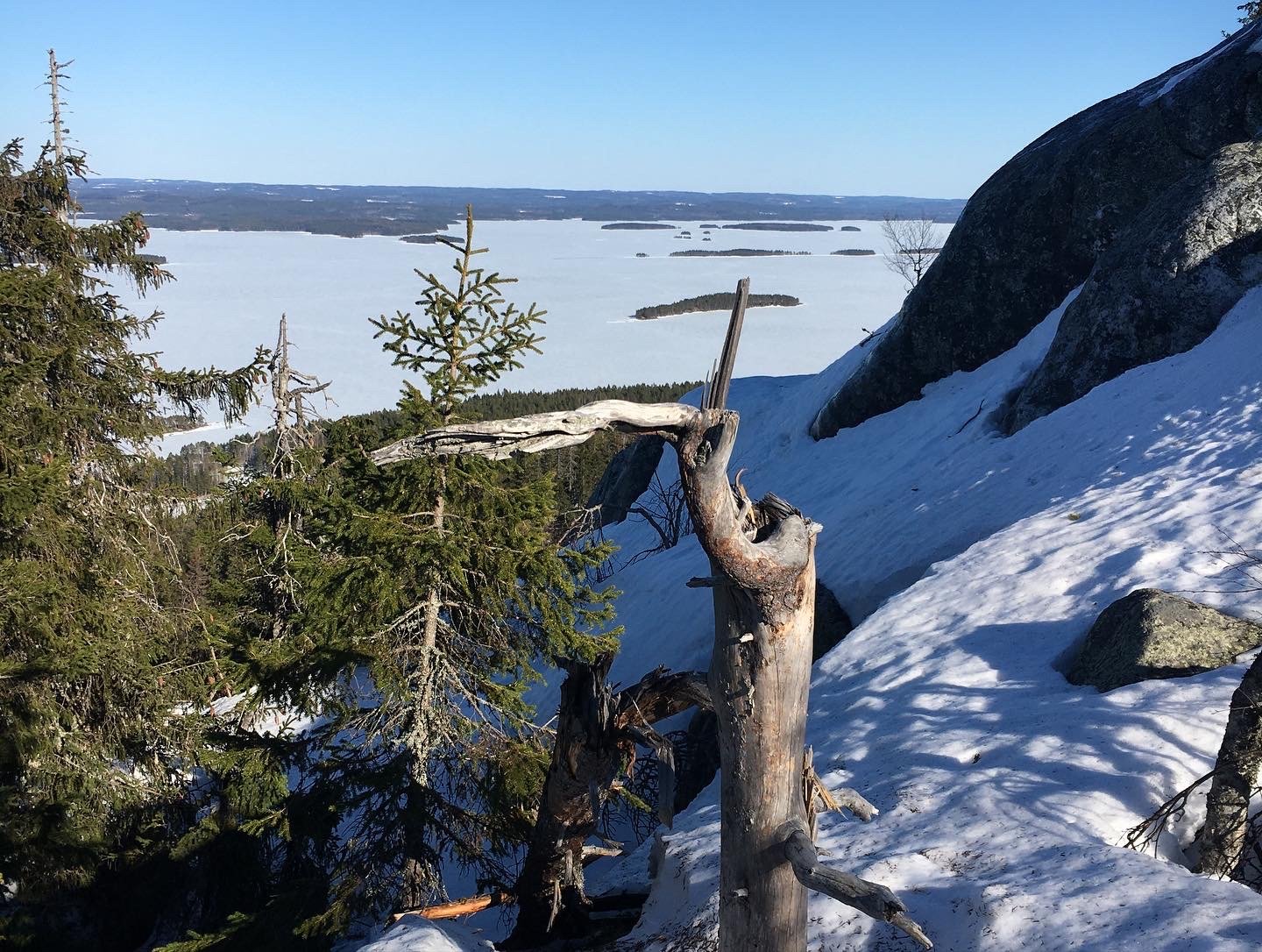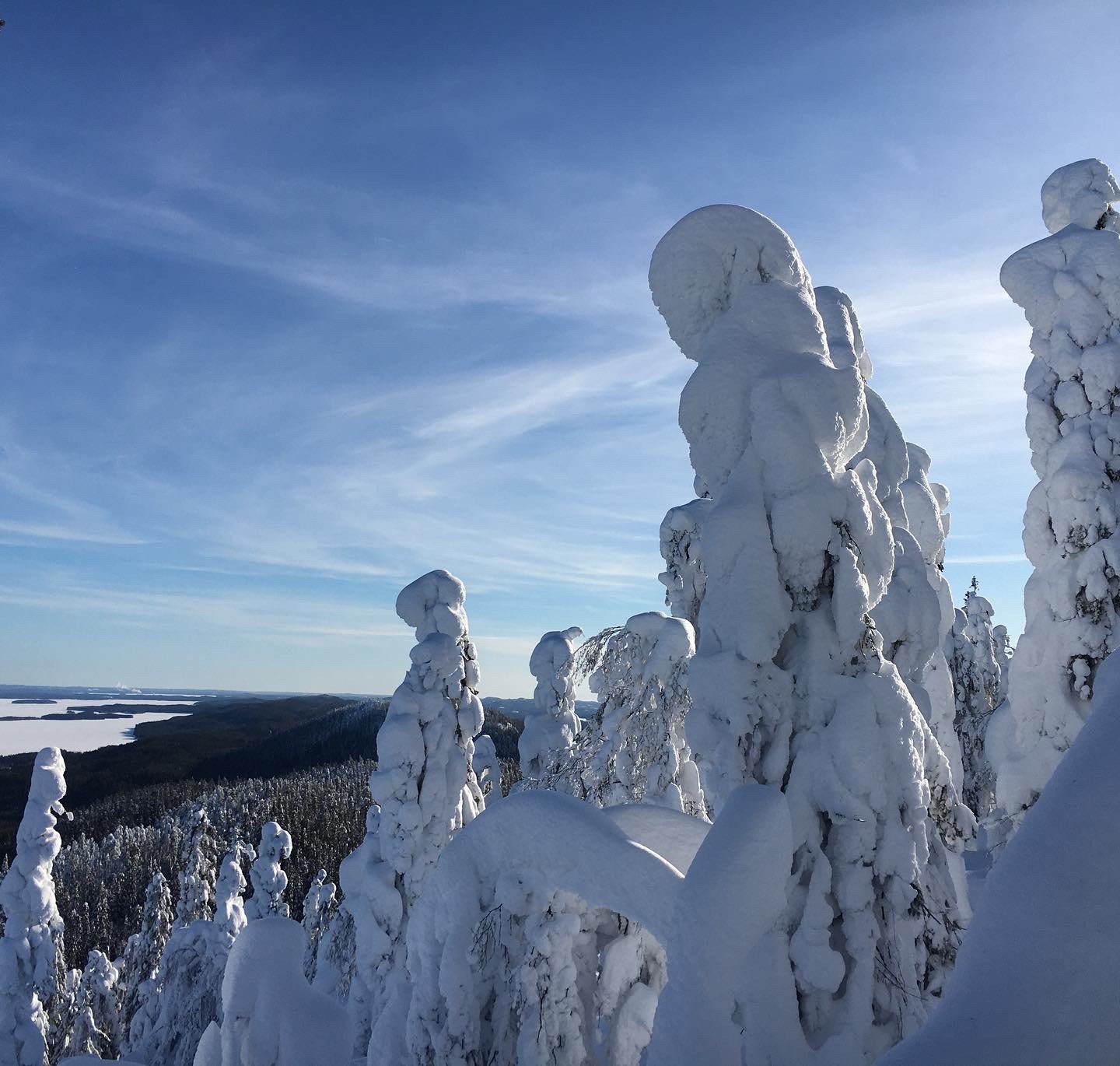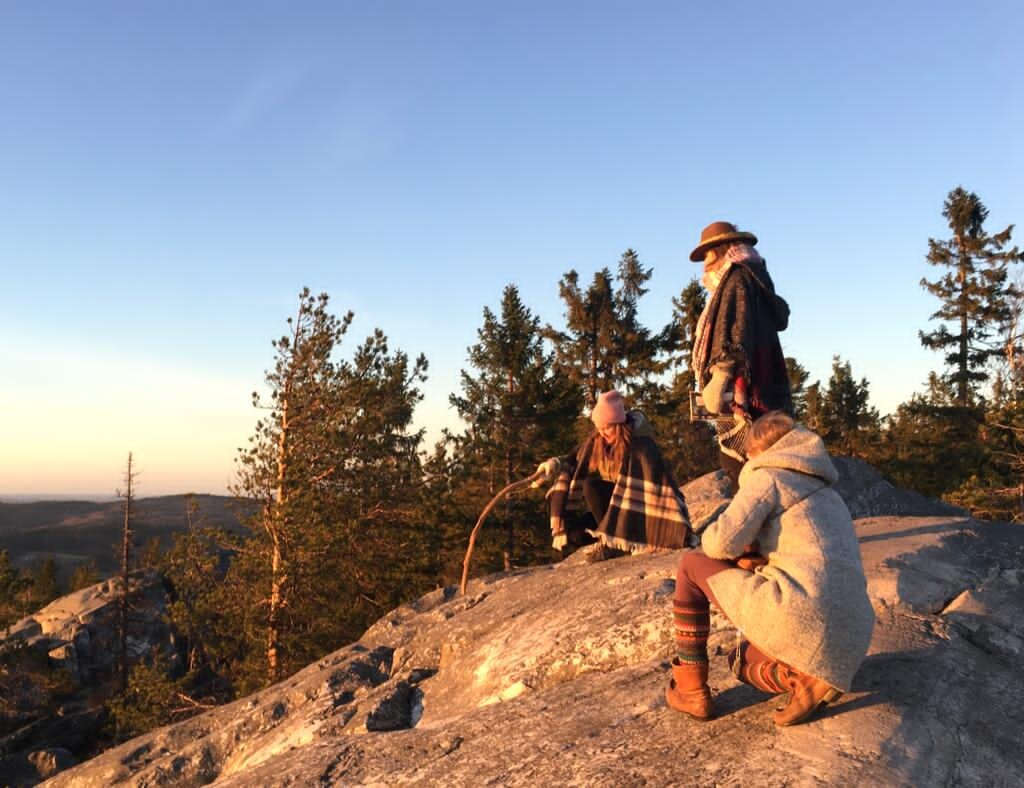MYTHICAL KOLI – The shamans, witches, and Wise Ones of the Sacred Mountain
”One Secret
One Spirit
One Happiness of both
is this church,
We will always remember its holiness.”
(in Finnish:
yksi salaisuus yks henki,
yksi onni kumpaisenki,
on kirkko tämä,
sen pyhyyttä muistelemma aina”)
These words were written by the national romantic landscape painter Eero Järnefelt in year 1893 to the walls of cave of the shamans and witches of Koli…the cave of Church of the Devil (Finnish: Pirunkirkko).
What has he experienced in the cave, so that he has written these words? What has he meant by the One Spirit as One Secret as One Happiness? Can you discover that secret?
Old shamanic power place
Animism means intellectual and spiritual, holistic understanding of life, that all beings of nature have their own purpose and reason for being here. Everything in nature is respected for their own soulfulness, for their own purposefulness, equally. People are not able to know nor decide the purpose of other beings – We can only live in sacred reciprocity with all of life. This means graceful cooperation and communication with all life, both what we can see with our eyes and senses, and what we cannot with our way of sensing. Shamans have been the ones who have always maintained this respect and understanding of the natural world.
Shamanism is considered as a healing, ritual, and ceremonial practice which lives the nature-centric, animistic connection with life. Shamans have been healers, priests, and ritual experts (Honko 1993, 74). They have been the ritual technicians of the sacred connections within the unseen and seen realms of existence. The connections between the heaven and earth, the profane and the spiritual, have been and are the respected territory of shamans work. The shaman has ensured the balance within all of life, and helped to remember the sacred rituals and ceremonies that are important for the community’s safety, well-being, and sense of self. The shamans themselves had and still have their own sacred places in nature, where they can sit in silence and listen to the advice from nature, prepare for the upcoming healing tasks and ceremonies, and ask help from the abundant spirit guides in the Lower and Upper worlds.
The shamanic work is very site-specific. It happens in connection with the surrounding environment. The shamans are able to define particularly powerful places in nature, which give support and healing influence for the rest of the world. Many of such sites are at Koli and around it, and the region as a whole can be also seen as very powerful place.
Bears and Shamans
As long known, Koli mountain, in North Karelia region in Finland, has been the sacred natural power place of the shamans, healers, and witches who have inhabited the region. The old name of the Koli mountain is Mustarinta or Mustarinda – meaning the Bear, which is the most venerated ancient totem of the region. The mythologies connected to the Bear are connected to the spirit of Koli. – perhaps the strongest ones. Yet Koli has much more mythical features than only the Bear. One of them would be also the Crow, which circumambulates the peaks of Koli, if you are lucky to see one. Last Sunday, also Eurasian Eagle-owl (in Finnish: huuhkaja), reminded me of its presence at Koli, and its significance for the shamanic knowledge of beyond day time.
At several places around Koli, one can find huge stones that are naturally forming a shape of the head of the Bear, or a shape of a whole bear. These sites have been used as ritual and ceremonial sites, as places of prayer, healing, and song. They have been and are places of empowerment, connection, and remembrance for shamans and for their adepts. These places are still used in equally venerated places of ritual by those ones, who remember and follow the footsteps by their ancestral guides, and apply their knowledge as it is suitable in today’s world.
Koli has been a sacred mountain, where the people came to give sacrifices even from long distance away, such as from Ilomantsi (Kemppainen). Similar way today as well, many travel across the country or even from abroad to visit Koli. Even if many travelers today might visit Koli as a leisure destination without spiritual meaning, they will anyway be affected by the powers of nature and the spiritual energy of the place. These connections happen much in subconscious and existential level, weather you are aware of it or not while visiting.
The bear has been very sacred and respected, kin for the human being. They can walk like a human being, and have many human-like features, such as ability to make tears, or eating similar foods (Honko 1993, 120). Last year, I found also from one of the cabins at Koli a photo of a mother bear with her cubs and the text from Kalevala in Finnish:
“Bear grew beautiful
Rised very complete
short leg, short knee
straight nose, nose grumpy
beautiful ruffled fur.”
I have not yet read the new book by Barbara Alice Mann and Kaarina Kailo (Oxford University Press, 2023) called “Woman who Married the Bear. The spirituality of the ancient foremothers”, but I am sure, that this book would enlighten ever further the significance of the bear totem for our collective northern spirituality.
The Old Times
“The official history” of Koli starts only from the 1400s, but the mythical and spiritual history before this has often been neglected and is not much remembered (oral source: author Kimmo Kemppainen, 21.1.21).
The islands of Hiekkasaaret at the Lake Pielinen can be seen from the top of Koli. These beautiful islands have fine sandy beaches, and according to author Kimmo Kemppainen, around here is “the place of the origins of the Earth”, the place for the Northern peoples, where the world has been born (oral source 21.1.21).
At the old times, Lake Pielinen used to have a lot of freshwater seals. In the mythical past, the seals were considered “the spirits of the waters”, but later the seals were hunted. The legend says, that the seal hunters formed a big “Jätinkirkko” (the church of the giants) two thousand years ago at Iso Mahonsaari Island at Lake Pielinen (oral source: author Kimmo Kemppainen, 21.1.21). I wonder, if the sacred spiral (in Finnish: Jatulintarha), that we built last July at the yard of the old village school of Jero (now the guest house Villa Ora’s) at Verkkovaara 1, Koli, is connected to the old Jätinkirkko at the island. In any case, building that stone spiral became part of the sacred sites of Koli, as the stones only bring to visible that which is already invisible in energy. Meanings of these stone labyrinths and spirals is a story of its own.
The spiritual changes
Korpi-Jaakko was the head priest of the Pielisjärvi municipality at the mid-1700s. It is said, that he was very devoted to push the Lutheran religion to the pagan region. He is said to have hated the shamans, witches, and tietäjäs of the region (Kemppainen). He has equally hated the Orthodox religion of the Karelia region. Korpi-Jaakko wanted to destroy all the “wrong beliefs”, paganism, nature spiritual traditions – any other form of belief than his own. Eventually he was able to convert a lot of people, who would row the traditional “church boats” to arrive as community to the church of Lieksa.
However, for a long time, people would go to church at the same time as they would still continue their devotion to their own natural spirits and ancient traditions. They would give offerings to their sacred trees and to the Nature Spirits. They would still honor the tradition-keepers, the wise ones, and the folk healers.
During this time in mid-1700s, two influential shaman-witches have been working at the Koli region. These were Ukko Kinolainen and a man called Vaara-Jaska Eronen. It is being recalled, that one autumn day, Korpi-Jaakko came together with his assistants from the church, and would destroy all the sacred nature sites of the local shamans, to cut the sacred trees, and to destroy all the sacred sites. I have heard, that there has been on the top of Koli also a sacred stone circle for ritual use, but also these stones would have been pushed away to the edge of the mountain.
Ukko Kinolainen and Eronen were completely horrified and became very angry, when they found out about what Korpi-Jaakko had done with his assistants. When the winter came, Ukko Kinolainen took his skis and skied across the lake to Lieksa. He approached the home of the priest, and look from the window, where he saw the priest having a dinner with his family. Nobody knows exactly, what happened, but the window broke. Korpi-Jaakko had come out with his sword. Ukko Kinolainen escaped to the church cemetery, and accidentally slipped on one of the open grave places that was waiting open for the upcoming funeral. Unfortunately, also Korpi-Jaakko slipped to the same grave after him. Korpi-Jaakko got very scared being on the grave together with the shaman, and tried to get up without any success. Ukko Kinolainen told him, that “You don’t get up from here anymore”. The priest had got so scared, that he had screamed so loud that he had jumped out from the grave. Luckily, Ukko Kinolainen was also helped out from the grave by a mythical person called Vorna. Vorna had actually been the one who had broken the window, and when the scared priest returned back to his house, Vorna asked him: “If your faith is so weak, is it right to destroy the faith of the other persons?”
Vorna and Korpi-Jaakko continued their discussion. Vorna told Korpi-Jaakko: “These dogmas of the church are being distributed and safeguarded by violence, and they are not connected to the real truth. You are also a Lutheran only, because you are born in Lutheran environment and believe in these dogmas that you have been taught.” Vorna explained to the priest, that he is not able to say, how close to truth are the shamans of Koli. That he destroyed the old sacred places of them, also says about the violent system. This again is completely strange behavior to the ones following the steps of Jesus. (Note: All these previous paragraphs are translated from the book by Kimmo Kemppainen on the mythical Koli.)
Restoring the shamanic ritual sites?
However, even today, the sacred places of Koli, such as the ancient stone circle, are not yet being restored. It is possible, that the national park could invite cooperation from associations such as Pielisen Tietäjät (a cultural association that promotes the shamanic cultural traditions of the region), or alike, to find solutions how to correct those mistakes of the past. It would be also wonderful to have more dialogue with the parish of Lieksa, to strengthen peace towards this shared history of the region, and find new forms of understanding. Few years ago, for example, the big wooden cross at Akka-Koli was renewed by the local church at the ancient shamanic power place. Even though these crosses might be set up with good and peaceful intentions, it would be wonderful to engage more dialogue with the shamanic community, in order to find the best practices in relationship with ancient spirituality and contemporary Christianity. This is to avoid making any acts that could be considered as continued religious colonization of the natural power places.
One of such colonial acts in the past has been the demonization of the old sacred natural power places by mapping the place names with scary names. For example, the Church of the Devil (in Finnish Pirunkirkko) should actually be called the Church of the Nature Spirit, as the womb of the Mother Earth (this name is my personal suggestion). The connection between the patriarchal religion and demonization of natural spirituality, can be seen also as a polarized act towards the natural feminine, the natural sexuality, the natural wilderness, and the Mother Earth. The controlled and hierarchical church believes used control over the wild side of life, including the natural spirituality of the people who lived close to nature. These topics are all too polarized, and quite sad. I believe, that we should work towards finding harmony with different spiritual believers and nature-lovers, and find ways to enlighten our understanding of each other and the spiritual aspects of nature. The nature spirits of Ukko-, Akka-, and Paha-Koli support this alignment towards peace and spiritual well-being of all.
Also, one of the tree mountain peaks of Koli is called Paha-Koli, which means the Evil-Koli. For the mystics and nature lovers, the Paha-Koli contains its beautiful secrets, and is nothing to done with the evil. It has been a sacred place, and it is just names as an evil, because of its mythical history on how people in old times threw the ones who had not abeyed the community rules, down from the hill cliff. Even today,
Sacrificial sites
One of the many sacrificial sites at Koli is right on the left side next to the Sokos hotel Koli at the top of the mountain. This place is called Uhrihalkeama, which is a big crack on the rock body of the Mother Earth. People have been throwing offerings to the rock. The offerings had to be big enough for pleasing the spirits. Today, this site is protected and one cannot enter close to it.
There are many other sacrificial sites at Koli other than Uhrihalkeama and the Bear stones. You can find old trees, other huge rocks, spots at the forest bed, and the water body of Lake Pielinen itself, as some of the possible places of giving thanks and gratitude for the Spirits of Nature and Ancestors.
One of the most abundant place of the Nature Spirits and Fairies at Koli is the area within the Waterfalls of Tarhapuro. Here, it is important to walk ever more gently, and not to step away from the nature trail, not to destroy the sensitive nature under the feet. It is good to keep quiet, and just to listen to the natural sounds of the water and the forest. See, how the sun light is playing in the forest, and open your senses to connect with the Nature Spirits.
Your intuition is your guide, as where you would like to give thanks or sit in prayer. The important thing is only that your sacrificial gift is not leaving a visible mark to the nature.
The mystical round circles around Koli
I remember, when I discovered for the first time one of the round circles at the rock body of Akka-Koli. Later, I would find similar and even bigger shape at one of my natural power places in Joensuu. I was delighted to find a short text written by Aimo Kejonen at the book Tarinoita Kolilta. Koli kautta aikojen II (2023, 303). He mentions six found circles, where he has found two of them at Akka-Koli, two by Akka- and Paha-Koli. He writes how he has seen them all at clean and even rock surfaces. They are all diameter of 10-30 cm. One of the circles is by the lake, and is about 70 cm. I think my power place in Joensuu has also a size like this, and is also by the lake.
Kejonen knows that circles like this can be found around Scandinavia. They are probably from late Stone Age or early Bronze Age, and they are considered to be involved in worshipping the sun. It is in deed a sun-like symbol. They have not made archeological research on the age of the circles found in North Karelia.
I have my own experiences with these mythical symbols, and they are important to me shamanistically. I have also drawn them in many of the shaman drums that I have been making, as symbols of empowerment and enlightened wisdom. The golden sun reminds us about the golden opportunity to use this life time to awaken our minds, and to learn about the connections with all of life. By connecting to the sun in spiritual way at those places where the circles are found, one can try to remember their collective meanings through our deep personal experiences.
The known and mythical male shamans
Perhaps the most famous of the old shamans of Koli has been Ukko-Kinolainen. Ukko Kinolainen has said to be so great shaman, that the waters of the spring started to boil, when he approached them. He has been moving around the Lake Pielinen region quite widely, as he is also mentioned in the history of the sacred nature site of Portti-Louhi in Juuka. In the magnificent Portti-Louhi canyon, there is a sacred stone gate, that Ukko Kinolainen, and another local shaman-healer-witch Höljäkän Noita Eskelinen have used in their ritual healing practices. The stone gate has been used as the keeper of the diseases, as the person with sickness or problem has went across the liminal space of the stones.
Kokkonen (2023) has written about Ukko-Kinolainen, how the shamanic or “tietäjä” work of him and his alikes were important, continuous, and well organized. The ritual experts knew their magic, and how to apply it in their service of healing, love-affairs and other family matters, agricultural duties, hunting and fishing, as well as in general uses of public order. The shamans and tietäjäs were strong and fearless persons, with natural abilities to communicate with the other-wordly. They might have been born with these abilities, or they were able to develop the abilities through the help of their family members with similar abilities, or other teachers who could advice them.
Ukko-Kinolainen lived within mid-1700s to the start of 1800s. He would also be called as a magician or as a wizard. Kokkonen has documented the sources, which have archived the written and oral sources about Ukko-Kinolainen. His real name was Matti Tossavainen, and he lived in a house called Kinolan talo for about 30 years. He was born 24.5.1771 at Pielisjärvi municipality and died in 1829. He was born in a place called Niemi, which was a community located within Hattusaari, Kelvänsaari, and Koli. His parents, Matti Ollinpoika Tossavainen and Riitta Siponen had total of 15 children, of which the last ones were twin brothers Paavo and Varpo. Ukko-Kinolainen got married in 28.2.1790 with Marketta Mustonen from Hattusaari village. She was eight years older than her wizard husband. They had two sons: Matti (1790-1816), and Juuso (1793-1861). It is said, that when the younger son tried to burn the wizards’s magic bag of his father after his death, he succeeded only on the fourth time. The magic bag had been jumping out from the fire three first times.
There are also accounts of a wizard called Kukkonen, who lived in a house called Louhivaara, but the legend recalls him being more of an evil kind. He had kept his magic tools in cave called Pirunkallio. Kokkonen writes, that he has had within his magical tools the “Black Book”, which has contained the magic charms and spells used by withes. It is told, that even in 1930s, the local people were still afraid of the area of his property. The Louhivaara property is nowadays called Lehtovaara, but close by it is still Louhikorpi and Louhilampi pond, and Pieni Louhilampi (small Louhi pond.). Louhi is the name for a witch that has trancendential qualities (in Finnish: loveenlankeava noita), and it is also used from a mythical Northern female character known also at Kalevala. Louhi is a witch that can travel to the other-worlds. The word is also connected to the caves (luola – louhi – lovi).
Kimmo Kemppainen has written two books in Finnish also about the mythical person called “Pielisen Vorna”. I appreciate, that Kemppainen has opened his mythical experiences at Koli unlike any other, sharing his “historical visions” about Vorna and his journeys across the lake Pielinen. However, for some reason, I am not myself connecting to that mythical figure, so I leave it to somebody else who has that connection.
The female shamans of Koli
The Finno-Ugric version for the female shaman has sometimes been considered the itkijä, the lamenter (Honko 1993, 75). The ritual crying has been an oral way of singing for the souls of the dead persons, for carrying them further to the heavens and returning to the mother earth, and for supporting the grief of the close-ones for the deceased member of the community.
I don’t know much about the lamenting culture around Koli in the past. However, I do know how the sacredness of Koli is inviting female shamanic practitioners and shamans today. Every summer full moon time, we can still hear the shamanic sounds at Akka-Koli. Those sounds invite to connect and remember the ones who walked in the past, to increase the wisdom in our hearts for living in balanced and healthy reciprocal way with nature, and to connect beautifully to each other as a human tribe. The work of the female shamans is very much that of the Great Mother – to spread love and care for all the nature family: the harmony between the living beings.
Photo taken of Helena by Justina Maslauskaite
(Note for the gender issues: Shamans are said to have the qualities of both gender, finally having experience of both genders in their spiritual work. A shaman can possess spirits of any kind, that are coming to give them help and advice, to deliver the guidance forward to those who need it. )
Koli has much mysteries and mythologies to continue to write about, to remember, and to connect to. As you enter the nature of Koli and some of the ancestral power places, please do remember to quiet down, to show respect, and to keep these places as clean and pristine as possible. As you sit quietly in one of these places, you might not know all its stories written or orally told, but you can deeply sense the grace through your senses. You can connect to the stars above Koli, or to the waters of Lake Pielinen below it, and participate in the heart space.
Sources:
Lauri Honko, Senni Timonen, Micheal Branch, and Keith Brosley (1993): The Great Bear. A Thematic anthology of Oral poetry in the Finno-Ugric languages. Finnish literature society.
Karjalainen: https://www.karjalainen.fi/maakunta/qclp02sqaf
Kimmo Kemppainen: Myyttinen Koli. Tarinoita Kolin noidista ja Pielisen sankareista. Omakustanne.
Jukka Kokkonen: Mikä mies oli Ukko-Kinolainen? In the book ”Tarinoita Kolilta”. 2023. p. 290-. Toim. Asko Saarelainen. Kolin kotiseutuyhdistys ry.







